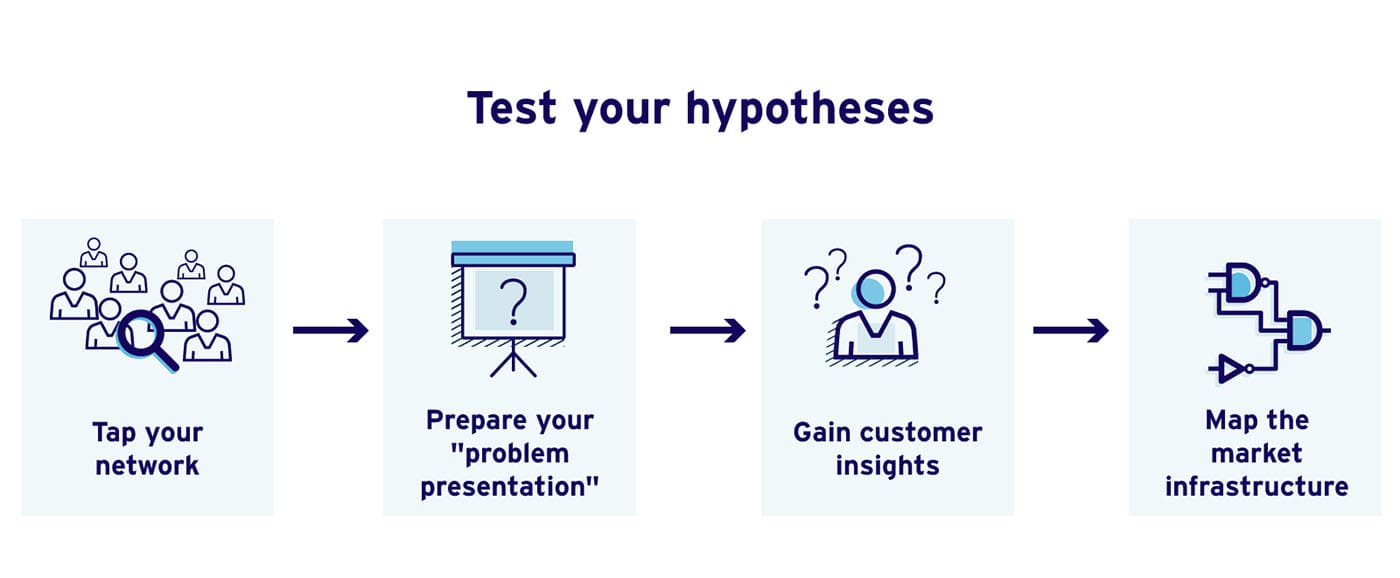Value proposition and Blank’s customer discovery method—Phase 2: Test your hypotheses
| Note: This article is part of a four-phase process designed to help entrepreneurs develop their value proposition. This article describes the second phase in the process which is based on the method of “customer discovery” in Steven G. Blank’s book, The Four Steps to the Epiphany.
The other three phases are discussed in the following articles:
For more information, see The Customer Development Model (CDM), product development and technology startups. |
Test your hypotheses
Once you have developed your product and market hypotheses, you are ready to start testing them with potential customers. The process of testing your hypotheses happens in four steps, described below.


Step 1: Tap your network
Begin by tapping your network: friends, former colleagues, investors, lawyers, accountants and so on. Build a list of potential customers on whom you can test your hypotheses. Steven Blank (see above) suggests the list should consist of fifty names. If need be, search industry magazines and other sources to find appropriate contacts. At this point, do not be too concerned about the position and rank your contacts as you are not selling to them: you are learning and gathering information.
Step 2: Prepare your “problem presentation”
Blank describes this step as “problem presentation.” Develop a presentation based on your hypotheses about customers and their problems as created in phase 1 of the customer discovery process. The purpose of the presentation is not to sell. This must be made explicitly clear. The point is to solicit feedback from your contacts regarding the severity of their problems (in terms of cost, efficiency loss or performance loss). Keep an open mind; in these situations, you will encounter problems and priorities that you had not anticipated. Remember that your goal is not to persuade others of your convictions, but rather to learn―so obtaining information that differs from your own view is positive. In your presentation, include a high-level description of your product idea and ask for feedback on that as well.
Step 3: Customer insights
While talking to your contacts, use the opportunity to acquire in-depth knowledge about their businesses by asking them questions beyond their problems. Focus your questions on understanding the context of their current operations. For example, ask about how a typical day is spent, how related processes are performed, what the main expense categories are, who the likely users would be of your solution, or who the likely buyers would be of your solution.
Step 4: Map the market infrastructure
Engage with industry analysts and the media and attend conferences and trade shows to gain a better understanding of the environment. Consider who your competitors might be, who has influence and power in this space (talk to them next), which companies are likely to buy, and what the trends are that occupy peoples’ minds in this market.
As you start exposing your hypotheses to potential customers, you will quickly learn facts which require you to modify your hypotheses.
By the end of this phase, you will have an updated “problem statement.” This is a brief that concerns the specific problem your target market faces.
You are now ready for the next phase of the customer discovery process, Value proposition and Blank’s customer discovery method―Phase 3: Test your product concept.
Researching a market? Our free online course Introduction to Market Sizing offers a practical 30-minute primer on market research and calculating market size.
References
Blank, S.G. (2005). The Four Steps to the Epiphany. Self-published: Cafepress.com.
Maurya, A. (2011). Running Lean. Self-published.
Ries, E. (2011). Lean Startup. New York: Crown Business.
Vlaskovits, P. and Cooper, B. (2010, July 29). The Entrepreneur’s Guide to Customer Development: A cheat sheet to The Four Steps to the Epiphany. Self-published.

